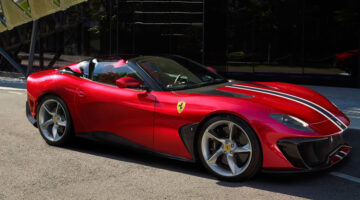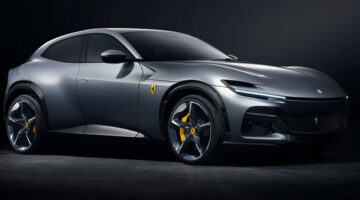The new Ferrari F8 Tributo combines Pista performance with GTB usability. The McLaren 720S is on notice
This is the Ferrari F8 Tributo, a new mid-engined V8 supercar designed to supersede the 488 GTB and close the gap to the McLaren 720S in terms of power, performance and no doubt price. Sharing its basic chassis and powertrain with previous 488 models, this is not an all-new car, but it has received a substantial design update, along with similar engine upgrades found on the track-focused 488 Pista.
Headline stats are as follows – the flat-plane crank 3902cc twin-turbocharged V8 has received a subtle power and torque boost to match the Pista, topping out at 711bhp at 8000rpm, with 568lb ft of torque available from 3250rpm. That torque figure is produced in Ferrari’s clever staged system too, gently building up the peak torque figure through the gears to give a more naturally aspirated feel to the whole powertrain. The transmission is the same seven-speed dual-clutch unit, but as we can think of no sharper gearbox in any other car, this is no bad thing. The F8 will hit 100kph in 2.9sec – a figure shared with both the previous Pista and current McLaren 720S. The 0-200kph figure is just 7.8sec, again identical to the 720S. Top speed is 340kph, a sole kph behind that pesky McLaren.
Ferrari quotes a ‘dry’ weight of 1330kg, with a caveat applied that the figure is only reached when ‘lightweight options are fitted’. This is in line with Ferrari’s recent quoting system. McLaren figures the 720S’s dry weight at 1283kg for context. The Ferrari’s weight disadvantage could be attributed to by many elements of the F8, but Ferrari’s adherence to an aluminium space frame chassis architecture, rather than the carbon tub favoured by McLaren, shows its limitations here.

The design is immediately recognisable as modern Ferrari, and like all recent series-production Ferraris was designed in-house at Ferrari Centro Stile. Although familiar, it does feature appreciable gains over the previous 488 GTB in terms of its aerodynamic efficiency and proficiency, says Ferrari. The 488 Pista’s front-mounted S-duct, for instance, is featured on the F8, increasing downforce on the front axle and smoothing airflow over the cabin. The outer ducts still feed cold air into a pair of radiators, while above the headlights are new brake ducts, cooling the standard carbon-ceramic rotors. The new horizontal LED headlights make a change from previous V8 models, which have utilised upright lighting units since the 458 Italia.
As fitting with the Tributo bit of its name, the rear introduces some gentle references to Ferrari’s past, including a return to double-roundel tail lights and a new Lexan rear screen incorporating slip vents like you might recognise from the F40. What the F8 still lacks is large-scale rear active aero like you might find on a 720S. The high-mounted twin-exhaust outlets sit in the same position as they did on prior 488 models, keeping the aggressive rear diffuser free of aero-disturbing exhaust gases.
The interior has a similar theme of the same, but different. The overall cabin architecture and layout is much as before, with a highly driver-focused layout of a central analogue tachometer flanked by a pair of TFT screens. The widescreen central screen as seen in the GTC4 Lusso and Portofino is not featured here.

The F8 Tributo will be seen in the flesh at the Geneva motor show next week, before a full launch later this year. It will sit somewhere over the $265k mark, with the inevitably expensive options list pushing most customer cars up much farther. The McLaren 720S is now on notice, and whisper has it there will be a new rival gunning for both McLaren and Ferrari. Watch this space.
| Ferrari F8 Tributo | McLaren 720S | Ferrari 488 Pista | |
|---|---|---|---|
| Engine: | 3902cc, twin-turbo V8 | 3994cc, twin-turbo V8 | 3902cc, twin-turbo V8 |
| Power: | 711bhp @ 8000rpm | 711bhp @ 7500rpm | 711bhp @ 8000rpm |
| Torque: | 568lb ft @ 3250rpm | 568lb ft @ 5500rpm | 568lb ft @ 3250rpm |
| Weight (dry) | 1330kg | 1283kg | 1280kg |
| 0-100kph: | 2.9sec | 2.9sec | 2.9sec |
| 0-200kph: | 7.8sec | 7.8sec | 7.6sec |
| Top speed: | 340kph | 341kph | 340kph |
This article originally appeared at evo.co.uk
Copyright © evo UK, Dennis Publishing



